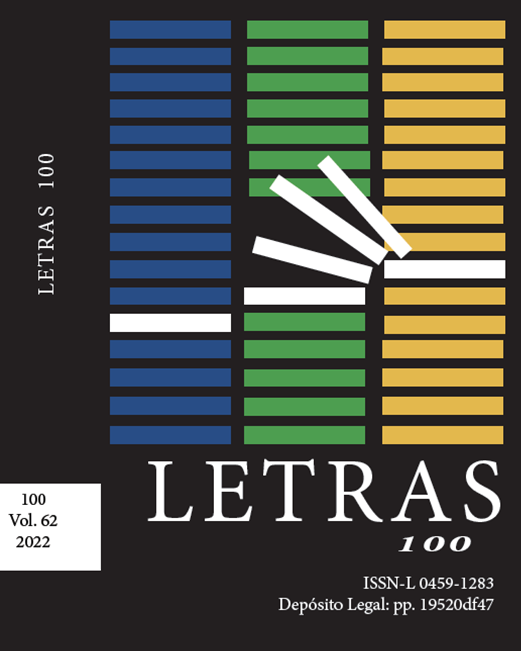Reading comprehension through the critical reading of paratexts
DOI:
https://doi.org/10.56219/letras.v62i100.103Keywords:
reading comprehension, critical reading, paratexts, critical reader traitsAbstract
The purpose of this study was to evaluate reading comprehension through the design of an instrument focused on the critical reading of paratexts, since we inquired about the traits of the critical reader that students between the ages of 12 and 18 should have. The theoretical scaffolding was based on Genette (1989, 2001), Cassany (2006), and Freire (2008). The methodology used in this research is field-based. The corpus was collected through a structured survey applied to a sample of 125 young people from five public and private institutions in Caracas. An analysis of the traits of critical reading was made and contrasted with the pertinent theoretical postulates. With this, it was evidenced that the students of the selected educational centers, in spite of having different ages, their form of analysis, interpretation and conclusions have developed just about the same. In other cases, partial analysis of the paratextual elements was recorded, except in some levels, specifically the higher ones, who analyzed in detail the advertisements presented, which does not mean that these students have the linguistic skills to optimally break down all the paratextual elements.
Downloads
References
Adrián, T. (2010). Apuntes para la discusión en el seminario de Lectura crítica o metatextual. Material didáctico utilizado en el optativo de profundización: Lectura y escritura; de la especialidad de Castellano, Literatura y Latín. Instituto Pedagógico de Caracas. Universidad Pedagógica Experimental Libertador.
Alvarado, M. (1994). Paratexto, “Enciclopedia Semiológica”. Oficina de publicaciones del Ciclo Básico Común de la Universidad de Buenos Aires.
Bloomfield, L. (1982). En el Diccionario de lectura y términos afines. Confeccionado por la International Reading Association. Ediciones Pirámide, 1985.
Carlino, P. (2005) Escribir, leer y aprender en la Universidad. Una introducción a la alfabetización académica. Fondo de Cultura Económica.
Cassany, D. (2006). Tras las líneas. Sobre la lectura contemporánea. Editorial Anagrama.
Cassany, Luna y Sanz (1998). Enseñar lengua. Graó.
Condemarín, M., Galdames, V., y Medina, A. (1997). Taller de lenguaje. Módulos para desarrollar el lenguaje oral y escrito. Dolmen Educación, 1995.
Ferreiro, E. (2000). Leer y escribir en un mundo cambiante. Conferencia expuesta en las Sesiones Plenarias del 26 Congreso de la Unión Internacional de Editores. CINVESTAV-México.
Fidalgo, A. (2019). La publicidad como persuasión: análisis de textos publicitarios Blog Tiza y lápiz. https://www.tizaylapiz.com/2019/01/la-publicidadcomopersuasionanalisis.html#:~:text=La%20publicidad%20es%20un%20modo,de%20pensamiento%20o%20de%20vida.
Freire, P. (2008). La importancia de leer y el proceso de liberación. Siglo Veintiuno Editores, 1984.
Genette, G. (1989). Palimpsestos. La literatura en segundo grado. Taurus.
Genette, G. (2001 [1987]). Umbrales. Siglo Veintiuno Editores.
knorr, P. (2012). Estrategias para el abordaje de textos. UniRío.
Paredes, J. (2004). La lectura. De la descodificación al hábito lector. http://www.bnjm.cu/bnjm/espanol/publicaciones/inicial.htm.
Roa, P. (2014). Los textos académicos: Un reto para docentes y estudiantes. Revista Sophia, 10, (2), 70-76. https://www.redalyc.org/pdf/4137/413734079008.pdf
Van Dijk, T. (1983) La ciencia del texto. Paidós.
Vygotsky, Lev S. (1973 [1934]). Pensamiento y Lenguaje. La Pleyade.
Published
How to Cite
Issue
Section
License
Copyright (c) 2022 LETRAS

This work is licensed under a Creative Commons Attribution-NonCommercial-ShareAlike 4.0 International License.
Letras magazine retains the patrimonial rights (copyright) of the published works, which favors and allows their reuse under the license (CC BY - NC - SA 4.0), for which they can be copied, used, disseminated, transmitted and expose publicly, as long as the authorship and original source of its publication (magazine, publisher, URL and DOI of the work) is cited, they are not used for commercial or onerous purposes and the existence and specifications of this use license are mentioned.















